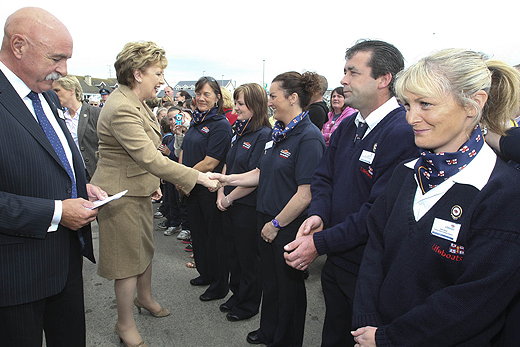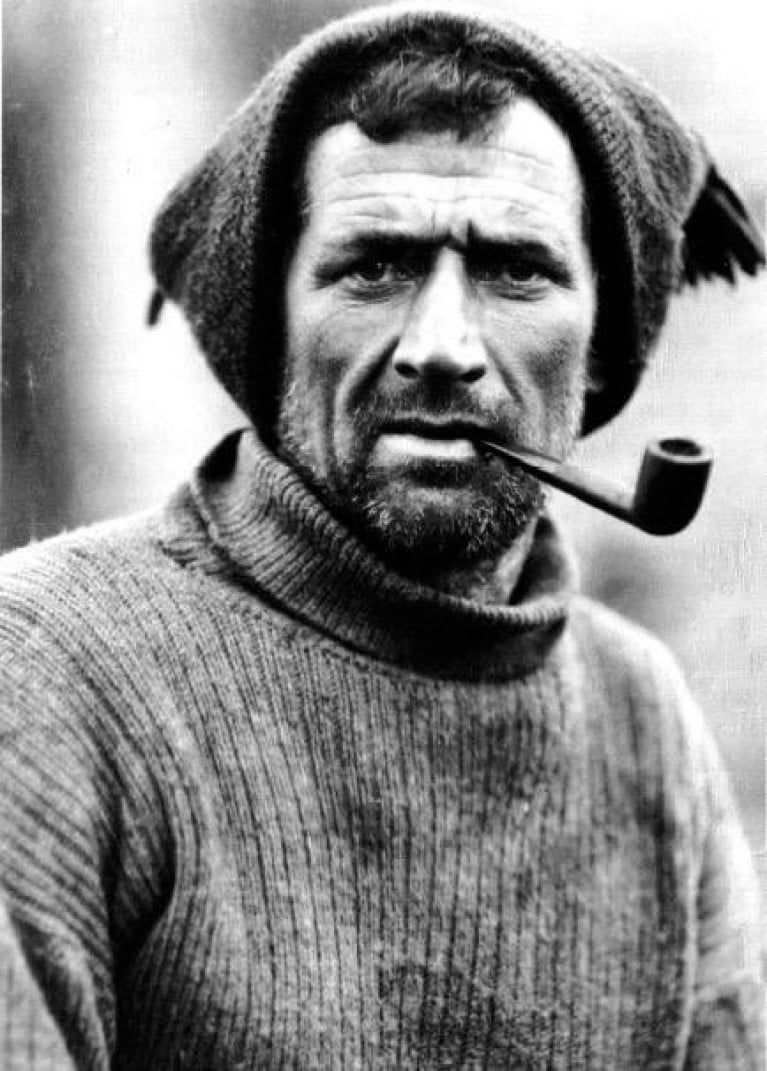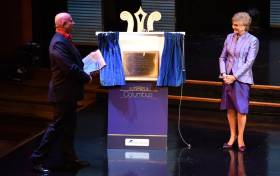Displaying items by tag: naming ceremony
Newbuild RV Tom Crean to Be Named After the Kerry Explorer Next Month in Dingle
RV Tom Crean, Ireland’s newest marine research vessel named after the Kerry explorer will be officially commissioned in Dingle next month, reports RadioKerry.
At almost 53-metres RV Tom Crean will be used (by the Marine Institute) for ocean surveys, fishery, acoustic and environmental research and buoy and mooring operations.
The €25 million newbuild recently docked in Galway Harbour, Afloat adds the homeport of the Spanish shipyard built ship which today is in the Celtic Sea having previously departed Cork Harbour.
Tom Crean's grand-daughter Aileen Crean-O'Brien will perform the commissioning ceremony in Dingle on October 6th.
She says it’s a proud moment for the family.
To listen, click here for an audio clip link.
Kerry Councillor Reiterates Call for Research Vessel RV Tom Crean to be Named in the County
A Kerry county councillor says it's appropriate that a vessel to be named after Kerry's Antarctic explorer would officially take place in the county.
The Marine Institute has commissioned a new research vessel, which is to be named the RV Tom Crean in honour of the explorer.
In 1893 at the age of 16, Tom Crean departed Minard in Lispole and joined the Royal Navy.
In the early 1900s, he was part of three British expeditions which had hoped to be the first to reach the South Pole.
He received an Albert Medal for his lifesaving efforts during the final expedition.
Last year, the Marine Institute commissioned a research vessel, which they intend to name the RV Tom Crean as revealed by Afloat back in January.
For more on the councillor's call, click onto Radio Kerry's coverage in addition the last update on the newbuild's progress.
#ferries - It was a new direction for long-established British ferry company, Red Funnel Ferries, the original Isle of Wight ferry operator, as today they welcomed their first ever-ro-ro freight ferry with a traditional ship naming ceremony.
Following 14 months in development, Red Kestrel, has become the newest addition to Red Funnel's fleet. The newbuild will also be the first dedicated Ro-Ro freight ship since the company’s inception almost 160 years ago.
The Great British-themed naming ceremony, which celebrated Red Kestrel being built in the UK, took place in Southampton docks by the Ocean Terminal and was witnessed by some 200 invited guests. Karen George, wife of Red Funnel’s Chairman, Kevin George, had the honour of christening Red Kestrel, with the traditional formality of breaking a bottle of champagne across the stern of the vessel.
Karen was accompanied by the Rt Hon Alok Sharma MP, Minister of State for Employment at Department of Work and Pensions, who also shared a speech highlighting the importance of British craftmanship, supporting local jobs and the revival of world-class shipbuilding in this country.
Opting for the build of the ship to be based within the UK, Red Funnel awarded the contract to the famous British shipbuilding company, Cammell Laird, based on the River Mersey at Birkenhead. In total, the project used 45 British supply chain businesses and generated 3,000-man hours of work for Cammell Laird's apprentices.
Commenting on the naming ceremony, Fran Collins, CEO of Red Funnel, said, “Today has marked a very special occasion in the history of Red Funnel. The addition of a new ship is always an exciting time for everyone, and Red Kestrel marks an important new direction for us as our first-ever freight ship.
“With the growth in the Isle of Wight economy over recent years, we had reached a point where we could no longer fulfil the growing demand. Following extensive research, we identified that to increase capacity on our passenger vessels, we would need a dedicated freight ferry to assist with the freight side of the business.
“Red Kestrel is designed to provide additional year-round freight capacity for our Southampton to East Cowes route, which currently handles 53% of all freight movements across the Solent.
“Our investment marks a vote of confidence that the UK and Isle of Wight economies are going to continue to grow and we can support this growth with the additional sailings Red Kestrel will provide.”
Tony Graham, Cammell Laird’s Chief Operating Officer, added: “Cammell Laird would like to thank Red Funnel for placing its trust in us to build this wonderful state-of-the-art ferry. Completing this ship sends a very strong message to the global maritime industry about Cammell Laird’s ferry building capabilities after we won the contract against international competition.
“Shipbuilding is back in a serious way on the Mersey and it has been brilliant to see the Red Kestrel being built alongside the iconic RRS Sir David Attenborough, which is the largest commercial vessel built in Britain for a generation We are proud to see the Red Kestrel join a collection of ferries that Cammell Laird has built in recent years.”
Red Kestrel will operate between Southampton and the Isle of Wight and will officially enter service in May. As a freight vessel, she is limited to 12 passengers and constructed specifically to provide additional year-round freight capacity for Red Funnel’s Southampton to East Cowes route.
At 74m in length, she will provide 265 lane metres of roll-on/roll-off freight capacity, allowing for 12 HGVs. To minimise the environmental footprint, the hull shape has been designed specifically to reduce wash and a propulsion package has been selected to make her highly fuel efficient.
The use of proven azimuth thrusters supplied by Rolls Royce will also make the ship very manoeuvrable. Her dedicated drivers-only lounge offers comforts and features such as access to hot/cold food, reclining leather seats with foot rests, free Wi-Fi and ample charging points.
Red Kestrel will use the same berths as Red Funnel’s existing Raptor class ro-pax vehicle ferries in Southampton and East Cowes.
Latest Addition to CMV Fleet Columbus Named As New Flagship
#NewFlagship- The latest addition to Cruise & Maritime Voyages fleet of new flagship Columbus as previously referred on Afloat was named at a glittering ceremony held at the London Cruise Terminal in Tilbury.
The Godmother to Columbus, who named the ship at the ceremony was TV personality Angela Rippon CBE. Whilst naming the ship, within the splendid Palladium show lounge, she told a delighted audience of the media, travel trade and VIP customers “I look forward to offering Columbus the same respect as my own godchildren.” Angela reminded the audience that Columbus discovered the New World of America on the 12th October 1492. “12th October is my birthday” she said.
The 64,000 tonnes ship will carry up to 1400 people and will be cruising year round from London – Tilbury. The cruise industry saw nearly 1.9 million people sail from a UK port last year and now with the arrival of Columbus, a new cruise ship for Britain, this is set to grow even further.
Chris Coates, Commercial Director at CMV said “When we introduced Magellan to our fleet just over two years ago, I suggested that it would be a game changer for us. Indeed it has been, and now we begin a new chapter as we proudly introduce our new flagship, Columbus, enabling us to respond to growing customer demand for traditional style cruising on board mid-sized cruise ships. The arrival of Columbus means we are on course to carry 100,000 passengers in 2018 cruising from the UK, which is 10% of the market.”
Mr Coates also announced that “Thanks to the support of our travel trade partners, we have sold over 95% of our 2017 Columbus cruise programme and an incredible 40% of 2018 capacity. Our Buy One Get One Free deals offer the best possible value and our customers recognise that it pays to book early.”
Columbus set sail from the London Cruise Terminal at Tilbury yesterday, Sunday 11th June, on her maiden three night cruise to Amsterdam and Antwerp. In glorious sunshine, a brass band and confetti cannons bid her bon voyage!
The season continues with cruises to the Norwegian Fjords, British Isles & Ireland (later this month), Iceland, Baltic Cities, Canary Islands & Madeira, Scottish Highlights & Faroes, Spain, Portugal, France & Gibraltar. In addiiton to a spectacular 46 night voyage to Cuba, Central America & the Caribbean.
President Mary McAleese names the first Tamar class RNLI lifeboat in Ireland at Kilmore Quay
The RNLI volunteers with Kilmore Quay lifeboat station are the first to receive the new €3 million lifeboat, which is the most modern and technically advanced lifeboat in the RNLI fleet. The new lifeboat, which is named Killarney (ON 1298) was funded by a legacy from Mrs Mary Weeks of Surrey in England who passed away in 2006.
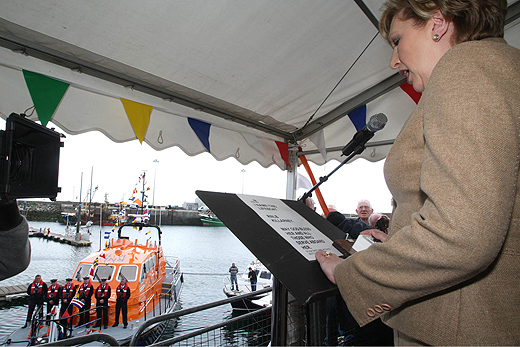
Mrs Weeks met her husband while on a cruise off the west coast of Scotland on a boat named Killarney. Mrs Weeks had a strong RNLI connection through her maiden name Distin. She was a relation of the Coxswain of Salcombe lifeboat Samuel Distin and of lifeboat crewmember Albert Distin; both men lost their lives in the Salcombe lifeboat disaster of 1916.
Mrs. Weeks' niece Mrs Betty Hull, her great niece Mrs Anne Piggford and great nephew David Hull were special guests at the ceremony. Speaking during the ceremony the President of Ireland, Mary McAleese addressed the crowds with the lifeboat alongside, " Everything that is good about human nature is gathered on this day. All the good qualities, all the things that people are capable of doing out of goodness, generosity, love, kindness, care concern; all gather around the naming of this boat this day. It comes to us by way of gift, it has been blessed and the gift itself is a blessing.
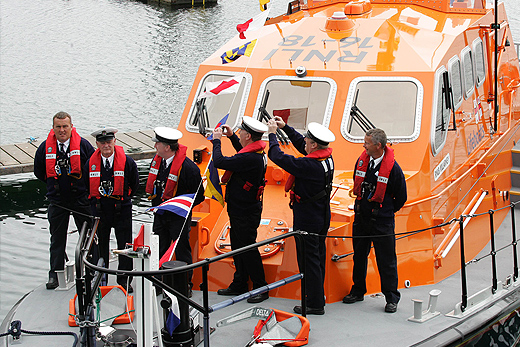
A blessing not just to those that take the boat into their ownership this day but to the people someday who will need this blessing and need its gift. For almost two hundred years now the RNLI has stories to tell of saving literally ten of thousands of lives. Tens of thousands of people who could call on the lifeboat, call on the volunteer crews and in particular without knowing it call on the generosity of people who would never get on the boat. Who like Mary Weeks would never see the boat, never live to see it but would give it as an act of generosity to future people, complete strangers who she would never know."
The new Tamar class lifeboat is 16.3 metres in length with a maximum speed of 25 knots compared to the 14.3 metres of the current Tyne class lifeboat stationed at Kilmore Quay, which has a maximum speed of 18 knots. The lifeboat is self-righting and is fitted with an integrated electronics systems and information management system, which allows the lifeboat crew to monitor, operate and control many of the boats systems from shock mitigating seats.
The Tamar also carries a Y boat (an inflatable daughter boat) which is housed under the aft deck and deployed from a hinged door in the transom. The lifeboat has room for 44 survivors.
